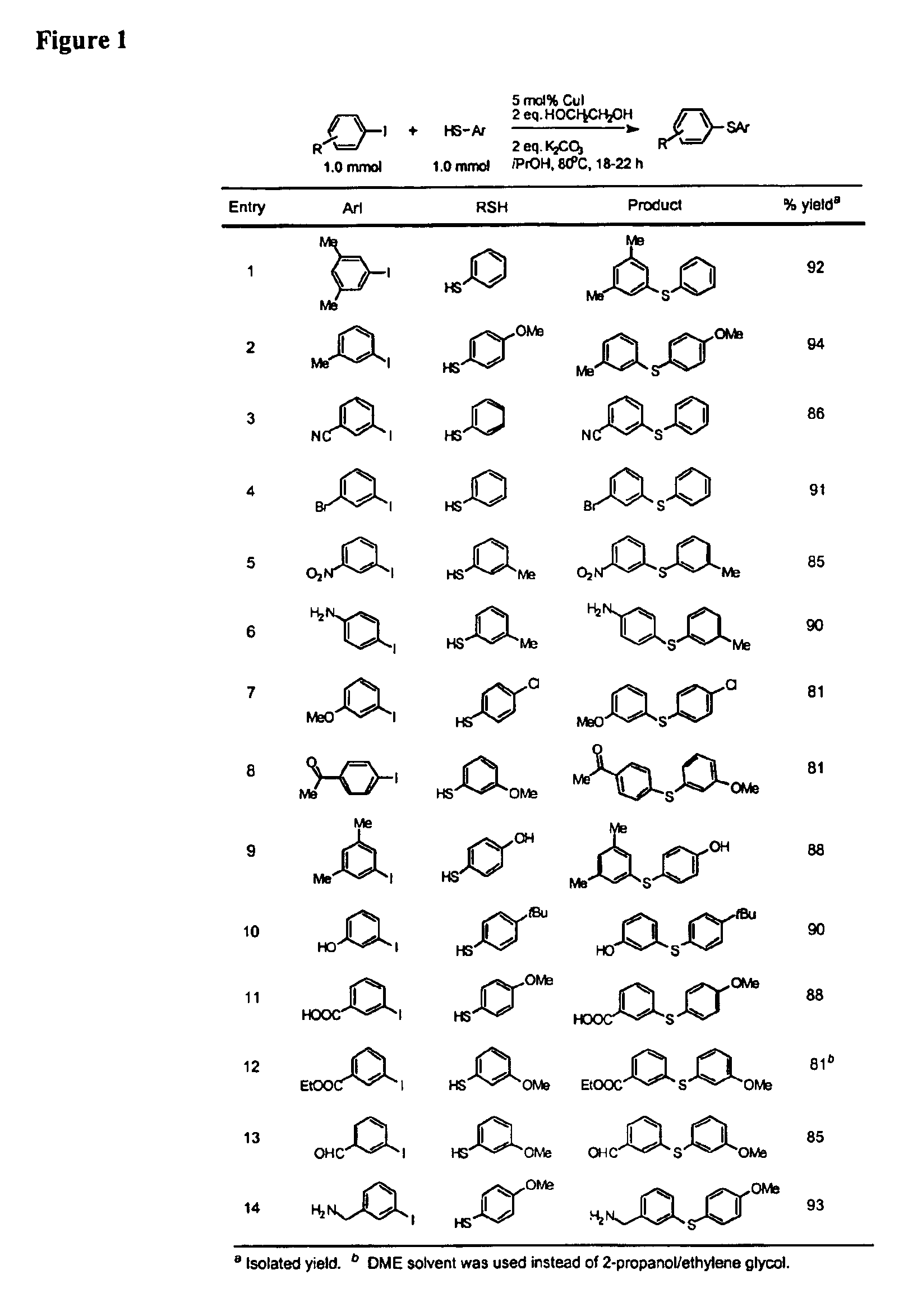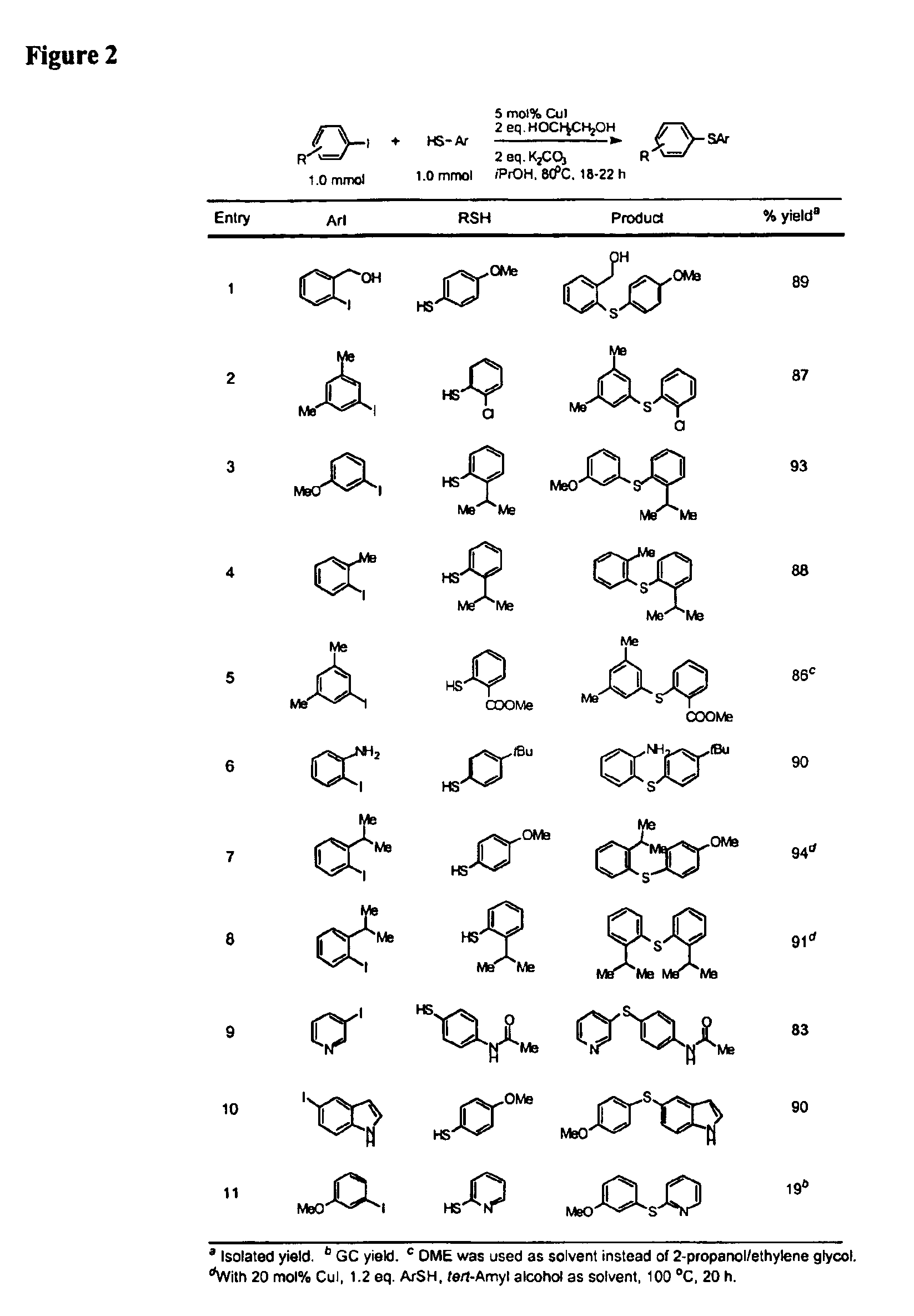Copper-catalyzed formation of carbon-heteroatom and carbon-carbon bonds
a technology of carbon-heteroatom and carbon-carbon bond, which is applied in the field of copper-catalyzed formation of carbon-heteroatom and carbon-carbon bonds, can solve the problems of ever-increasing cost of palladium, affecting the allure of these powerful methods, and being incompatible with base-sensitive functional groups, so as to achieve low cost of copper and be convenient to us
- Summary
- Abstract
- Description
- Claims
- Application Information
AI Technical Summary
Benefits of technology
Problems solved by technology
Method used
Image
Examples
example 1
General Procedure for Cu-Catalyzed Carbon-Sulfur Bond Formation (See FIGS. 1-3)
[0222]Cu(I) iodide (10 mg, 0.05 mmol), potassium carbonate (276 mg, 2.0 mmol) and aryl iodide (1.0 mmol, if a solid at ambient temperature) were added to a screw-capped test tube with a Teflon-lined septum. The tube was evacuated and backfilled with argon (3 cycles). 2-Propanol (1.0 mL, bench top grade solvent without degassing and pre-drying), ethylene glycol (111 μL, 2.0 mmol, bench top grade solvent), aryl iodide (1.0 mmol, if a liquid at ambient temperature) and thiols (1.0 mmol) were added by syringes at room temperature. The tube was heated to 80° C. and stirred for 18-22 hours. The reaction mixture was then allowed to reach room temperature. Ethyl acetate (approx. 5 mL) and dodecane (227 μL, GC standard) were added. The aliquot was analyzed by GC. The reaction mixture was then filtered and concentrated. The crude product was purified by column chromatography on silica gel to afford the desired thio...
example 2
Cu-Catalyst Screening for Cu-Catalyzed Carbon-Sulfur Bond Formation (See FIG. 4)
[0223]Copper complex (0.05 mmol) and potassium carbonate (276 mg, 2.0 mmol) were added to a screw-capped test tube with a Teflon-lined septum. The tube was evacuated and backfilled with argon (3 cycles). 2-Propanol (1.0 mL, bench top grade solvent without degassing or pre-drying), ethylene glycol (111 μL, 2.0 mmol, bench top grade solvent) and 5-iodo-m-xylene (144 μL, 1.0 mmol), thiophenol (103 μL, 1.0 mmol) were added by syringes at room temperature. The tube was heated to 80° C. and stirred for 20 hours. The reaction mixture was then allowed to reach room temperature. Ethyl acetate (approx. 5 mL) and dodecane (227 μL, GC standard) were added. The aliquot was analyzed by GC or GC-MS. See FIG. 4.
example 3
Base Screening in Cu-Catalyzed Carbon-Sulfur Bond Formation (See FIG. 5)
[0224]Copper(I) iodide (10 mg, 0.05 mmol) and base (2.0 mmol, if solid) were added to a screw-capped test tube with a Teflon-lined septum. The tube was evacuated and backfilled with argon (3 cycles). 2-Propanol (1.0 mL, bench top grade solvent without degassing and pre-drying), ethylene glycol (111 μL, 2.0 mmol, bench top grade solvent), base (2.0 mmol, if liquid) and 5-iodo-m-xylene (144 μL, 1.0 mmol), thiophenol (103 μL, 1.0 mmol) were added by syringes at room temperature. The tube was heated to 80° C. and stirred for 20 hours. The reaction mixture was then allowed to reach room temperature. Ethyl acetate (approx. 5 mL) and dodecane (227 μL, GC standard) were added. The aliquot was analyzed by GC. See FIG. 5.
PUM
| Property | Measurement | Unit |
|---|---|---|
| Electric charge | aaaaa | aaaaa |
| Electric charge | aaaaa | aaaaa |
| Electric charge | aaaaa | aaaaa |
Abstract
Description
Claims
Application Information
 Login to View More
Login to View More - R&D
- Intellectual Property
- Life Sciences
- Materials
- Tech Scout
- Unparalleled Data Quality
- Higher Quality Content
- 60% Fewer Hallucinations
Browse by: Latest US Patents, China's latest patents, Technical Efficacy Thesaurus, Application Domain, Technology Topic, Popular Technical Reports.
© 2025 PatSnap. All rights reserved.Legal|Privacy policy|Modern Slavery Act Transparency Statement|Sitemap|About US| Contact US: help@patsnap.com



